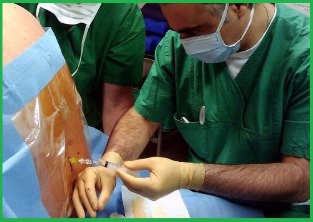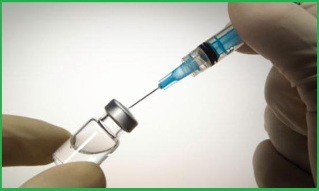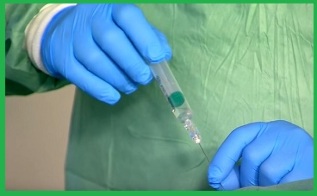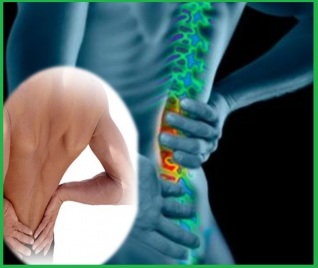Pain in the back and the waist can occur at any age. To quickly find treatment and get rid of the discomfort, it is necessary to establish the source of pain. Most often this can be the consequence of hypothermia, vertebral hernia, the result of injuries and accidents, sciatica or diseases of the musculoskeletal system. Correct diagnosis and a doctor's statement will be the beginning of effective treatment and prevents the development of disease and complications to other organs.

First you need to pass a comprehensive examination of the whole body, to consult the doctors. In some cases, back pain is a signal about the presence of inflammatory processes in the body and diseases of internal organs. To exclude them, it is recommended to be examined by a gynecologist, urologist and gastroenterologist. Identifying the cause of the pain, the doctor prescribes medication. Based on the nature of the pain syndrome and associated manifestations, selected individual complex of preparations.
Painkillers
When back pain and lower back, the doctor prescribes some pain medications, among them non-steroidal anti-inflammatory drugs (NSAID) and vitamins of group B. They not only eliminate strong pain, but also help to cure inflammation, have a calming effect on the affected areas of the back.
Please note! During the medical treatment of pain, doctors recommend to maintain physical activity of the patient. In parallel with the injection, prescribe a course of massage and therapeutic exercise.
Vitamins B1, B12, B6 relieves pain and have good action. This group of drugs has a positive effect on metabolic processes in the body, improve the nervous system, regenerate the damaged nerve endings. Injections of vitamins that help to deal with severe pain, chronic manifestation of pain syndrome such injections are ineffective. The course of treatment lasts on average 12-14 days, followed by improvement of the patient's condition.
If prolonged pain medicine there are no visible results, the doctors resorted to the method of injections and stretching. The procedure performed by the physician, the patient is in a prone position and places of greatest pain and seals the injected solution of novocaine. After the injection you need a little to stretch the affected area of the back and to make a hot compress. After the procedure, the patient is encouraged to perform active movements and to increase the load on the painful muscle. Thus, developed motility.
Chronic aching pain, it is necessary to identify the Central and repulsed. Based on type of pain and the possibility of side effects from the gastrointestinal tract and cardiovascular complications, we choose the optimal drug list. In most cases, it looks like this:
- for dyspepsia prescribed Nimesulide, Ibuprofen or their analogues (Diclofenac, Naproxen, Meloxicam);
- in the absence of pain in the upper abdomen you can apply any anti-inflammatory drug;
- at the risk of gastrointestinal bleeding, together with chopping NSAIDs proton pump inhibitors (Omeprazole);
- in cardiovascular complications in the composition of the injection include opioids, Paracetamol, Nimesulide (mandatory is the measurement of blood pressure);
- in the presence of chronic diseases of the GASTROINTESTINAL tract and cardiovascular abnormalities Omeprazole and Nimesulide combined with Aspirin.
With proper early treatment, the pain diminished within a week after the start of treatment. To avoid relapse, you must complete a full range of injections to complete relief of pain.
Important! If after anesthetizing injections comes relief, diagnosis of the organism for the exclusion of tuberculosis, gonorrhea, syphilis and other pathologies that affect the spine and joints.
Anti-inflammatory injections
Back pain is often accompanied by inflammation of internal organs and tissues, getting rid of them, you need to start treatment pain. Used to treat inflammation NSAIDs are divided into two large groups, which differ not only in drug composition, but also the effect on the digestive tract.
There are two groups of NSAIDs: selective and nonselective inhibitors of COX. Contribute to nonselective inhibition of cyclooxygenase enzymes that participate in the formation of inflammatory mediators. But these drugs do not affect the internal organs of the gastrointestinal tract, they can trigger the formation of gastric ulcers.

Selective NSAIDs more gentle effects on the stomach have no side effects and does not affect articular cartilage. Drugs of this type can take much longer, without violating the normal functioning of internal organs.
One of the non-selective NSAID is Diclofenac or its analogues Ortofen, Voltaren, Naklofen. The product is used for pain, arthritis, osteoarthrosis, spondylitis, gout pain, postoperative pain and discomfort after injuries. The standard dose is one ampoule (75 mg), acute pain — 150 mg per day. Injection is injected into the gluteal muscle.
Contraindications to the use Diclofenac:
- pregnancy;
- lactation;
- children's age (up to 18 years of age may be exceptions and individualized dosage);
- ulcer of the stomach;
- diseases of the liver.
The most common nonselective NSAIDs is considered Movalis (Meloxicam, Amelotex, Artrozan). The drug is used in chronic arthritis, spondylitis, rheumatoid arthritis, acute osteoarthritis. Is injected intramuscularly in the initial stages of the disease or in acute pain. Next is the pill.
Contraindications:
- pregnancy;
- the breast-feeding period;
- heart failure;
- children up to age 15 years;
- ulcer of the stomach;
- tendency to bleeding of the GASTROINTESTINAL tract and other organs.
Relieve pain and eliminate inflammation help preparations containing vitamins of group B. they are Extremely effective in the acute stage of the disease. Among them Milgamma component of which is pyridoxine hydrochloride (B6), thiamine hydrochloride (B1), cyanocobalamin (B12), lidocaine hydrochloride with complex auxiliary components. The injection is performed intramuscularly once a day for 2 ml To maintain the result and prevent recurrence, when a sharp pain disappears, injected at 2 ml up to three times a week.

Milgamma is indicated for pain in muscles, neuritis, neuralgia, weakness and polyneuropathy. A contraindication to the injections is:
- pregnancy;
- lactation:
- the patient's age till 16 years;
- heart failure.
An injection of three drugs
For the relief of back pain use an injection of three drugs, the active ingredients are diphenhydramine hydrochloride, analgin and papaverine. Drugs together in a single injection and administered intramuscularly. The injection effectively reduces the sharp pain, provoked by diseases of the musculoskeletal system and posttraumatic complications. In addition, the injection has the property of lowering the temperature.
Diphenhydramine in the composition of the injection blocks the receptors in the periphery and has a sedative effect. Papaverine is considered to be antispasmodic drug which affects the smooth muscle of blood vessels. Analgin is used as an anesthetic.
The dosage is prescribed by a doctor according to the type of pain and the individual tolerance of drugs. Standard injection comprises 1 ml of 1% Dimedrol, 2 ml of 2% Papaverine and 2 ml of a 50% solution of analgin.
Please note! Analgin can cause allergic reactions. Allergies replace it with aspirin.
Injections for sciatica
Treatment of sciatica is a shot inside the muscle anti-inflammatory and analgesic agents. In addition, the doctor may prescribe medications that will help to remove swelling in the affected area of the back and to improve trophical processes. Injections give a positive result much sooner than the pills. To eliminate the pain in the back are being prescribed these drugs:
- Voltaren. Refers to the number of anti-inflammatory drugs used to treat sciatica, and rheumatic diseases. The injection is injected deep into the muscle, it is impossible to repeat the injections more than two days in a row. To enhance the effect, Voltaren can be combined with tablets.
- Have Ketonal. The drug is in the group of NSAIDs and is often assigned not only with sciatica but other pathologies of the spine and musculoskeletal system. Have Ketonal eases pain and prevents excessive sensitivity of pain receptors.
- Injection of ozone. A new method of combating back pain is the injection of ozone. It is securely eliminate back pain, but applies only once by injection into the affected area of the back.
Injections hernia
Hernia treatment medical way includes mandatory injections for pain of the back and relaxation whose terminations. An injection of novocaine will effectively relieve the pain in the back and long retains the result. The procedure should only be performed by specialist, incorrect solution can trigger a violation of motor function of the spine and nervous system of the patient. There are two types of novocaine blockade, which differ in the method of drug administration:
- injections between the ribs with a special needle (the doctor injects novocaine solution in constricted nerve, it is very important not to fall into the neurovascular bundle);
- epidural injections, which are introduced between the hard shell of the spinal cord and the periosteum of the vertebral canal.
In addition to novocaine blockade and epidural injections, the person requires constant monitoring and support of health status. A doctor can be administered NSAIDs, vitamin complexes, and pain medicine. A comprehensive approach to addressing the causes of pain, will help in the shortest possible time to get rid of the discomfort in the back and lower back.

In modern medicine there are several medications that can help eliminate pain and reduce inflammation. Among them the following medications:
- Traumeel. To treat anti-inflammatory, analgesic drugs. Prescribed for strong pain syndrome. Adult dosage is one ampoule per day, massive damage to the back possible the injection of two ampoules. Children up to six years administered the fourth part of the ampoule as directed by your pediatrician.
- AIDS, HIV infection;
- multiple sclerosis;
- tuberculosis;
- leukemia;
- lupus and autoimmune disease of the connective tissue.
- Alflutop. The drug prevents the destructive processes in the tissues and restores the articular cartilage, has analgesic property. The treatment course is twenty days, one ampule (1 ml) per day. Injection is administered intramuscularly.
- pregnancy;
- breast-feeding;
- individual intolerance to components of the medication;
- child age of the patient.
- Dexamethasone. The remedy is assigned for rheumatic diseases and diseases of the connective tissue. At moderate pain syndrome, the patient is injected one ampoule per day. In acute disease, the doctor individually selects a dose that can vary from 4 mg to 20 mg per day. The course of treatment is four days, then the patient is taken on tablets.
- hypersensitivity to the drug;
- gastrointestinal disease;
- child age of the patient (exceptions are made individually with a decrease in dosage);
- infectious diseases;
- endocrine diseases;
- pregnancy.
- Diprospan. The drug is widely used in osteochondrosis, osteoarthrosis, post-traumatic syndromes. The drug is administered intramuscularly one ampoule per day. In the period of acute pain may increase the dosage.
- ulcer of the stomach;
- diabetes mellitus;
- tuberculosis;
- glaucoma;
- psychosis.
Contraindications are:
If the affected large areas of the joints, the dose may be increased up to 2 ml per day. After the full course of treatment, through the floor, you can go to re-treatment.
Restrictions apply:
Contraindications:
Contraindications to the use of:
If medical treatment of back pain and lower back does not give the desired result, you should consult with a physician and undergo an additional examination of the body. If you do not find the cause of the disease, the treatment will be ineffective.
In medicine, practiced combined treatment: medications combine with exercise and massage. Regular exercises are aimed at stretching the spine to increase its mobility and to remove the feeling of "stiffness". If medication does not help, the only way to get rid of the pain is surgery.
Injections for back pain and lower back have a positive effect for early start of treatment. Neglected diseases of the spine require long-term treatment and sometimes surgery.

























